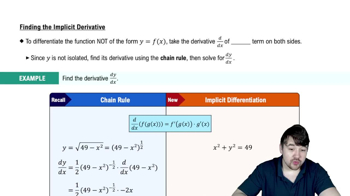Table of contents
- 0. Functions7h 52m
- Introduction to Functions16m
- Piecewise Functions10m
- Properties of Functions9m
- Common Functions1h 8m
- Transformations5m
- Combining Functions27m
- Exponent rules32m
- Exponential Functions28m
- Logarithmic Functions24m
- Properties of Logarithms34m
- Exponential & Logarithmic Equations35m
- Introduction to Trigonometric Functions38m
- Graphs of Trigonometric Functions44m
- Trigonometric Identities47m
- Inverse Trigonometric Functions48m
- 1. Limits and Continuity2h 2m
- 2. Intro to Derivatives1h 33m
- 3. Techniques of Differentiation3h 18m
- 4. Applications of Derivatives2h 38m
- 5. Graphical Applications of Derivatives6h 2m
- 6. Derivatives of Inverse, Exponential, & Logarithmic Functions2h 37m
- 7. Antiderivatives & Indefinite Integrals1h 26m
- 8. Definite Integrals3h 25m
4. Applications of Derivatives
Implicit Differentiation
Problem 3.8.14b
Textbook Question
13-26 Implicit differentiation Carry out the following steps.
b. Find the slope of the curve at the given point.
x = e^y; (2, ln 2)
 Verified step by step guidance
Verified step by step guidance1
Start by differentiating both sides of the equation x = e^y with respect to x, applying implicit differentiation. Remember that the derivative of e^y with respect to x involves the chain rule, so you'll need to multiply by dy/dx.
Rewrite the differentiated equation to isolate dy/dx. This will give you an expression for the slope of the curve in terms of x and y.
Substitute the given point (2, ln 2) into the equation you derived for dy/dx. This means replacing x with 2 and y with ln 2.
Calculate the value of e^(ln 2) to simplify your expression, since e and the natural logarithm are inverse functions.
Finally, evaluate the expression you obtained for dy/dx at the point (2, ln 2) to find the slope of the curve at that specific point.
Recommended similar problem, with video answer:
 Verified Solution
Verified SolutionThis video solution was recommended by our tutors as helpful for the problem above
Video duration:
4mPlay a video:
Was this helpful?

 5:14m
5:14mWatch next
Master Finding The Implicit Derivative with a bite sized video explanation from Nick
Start learningRelated Videos
Related Practice



